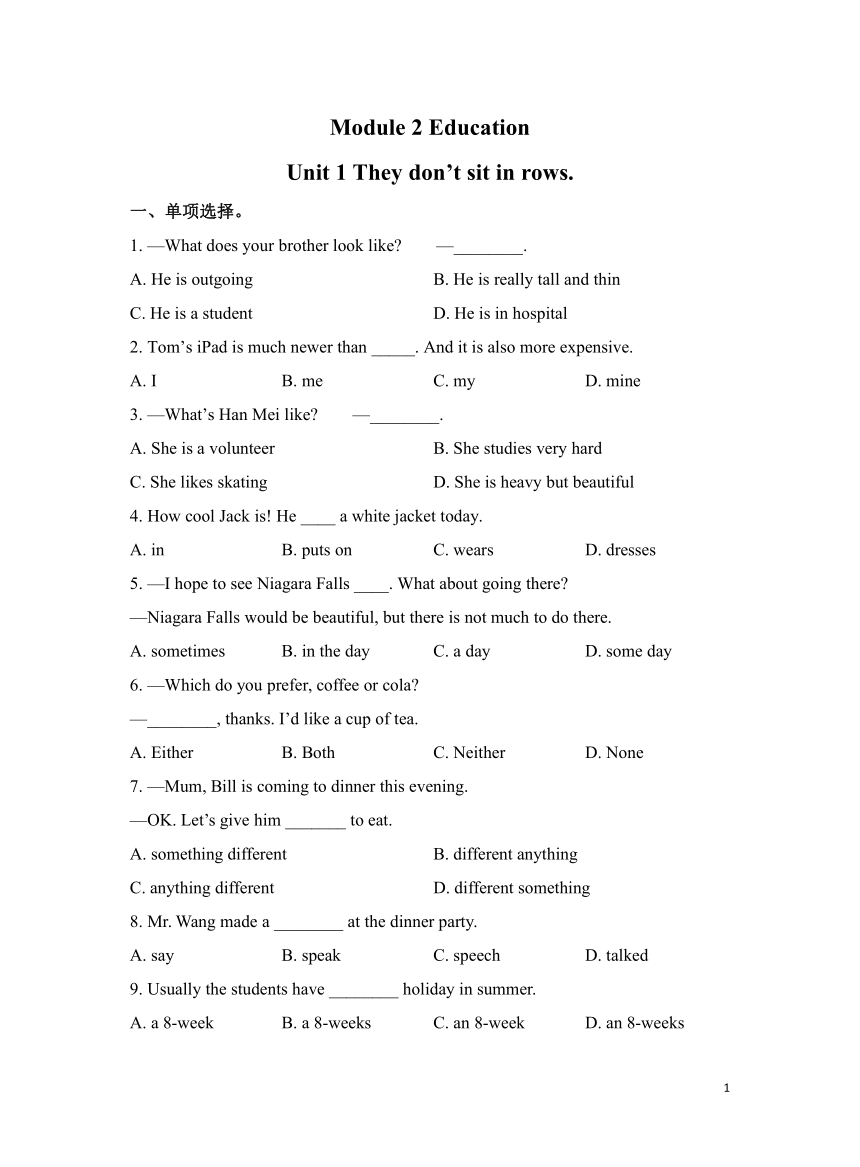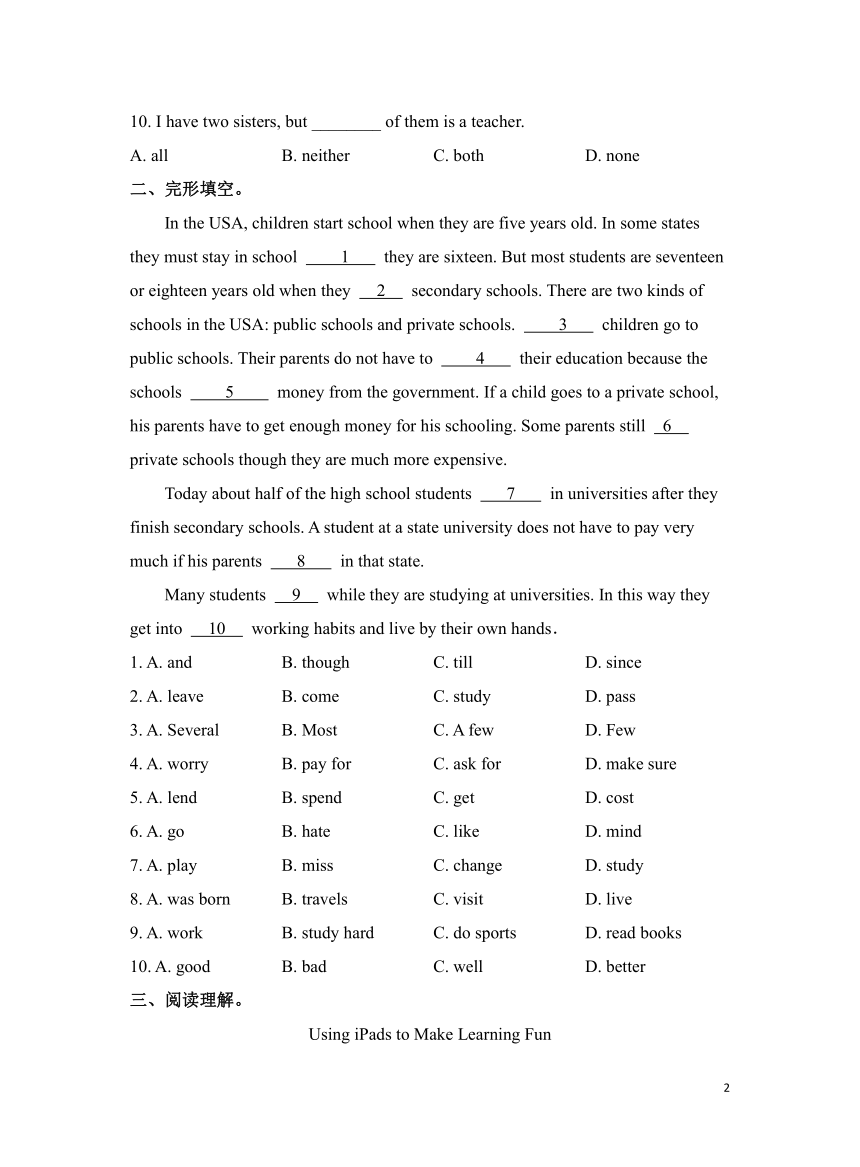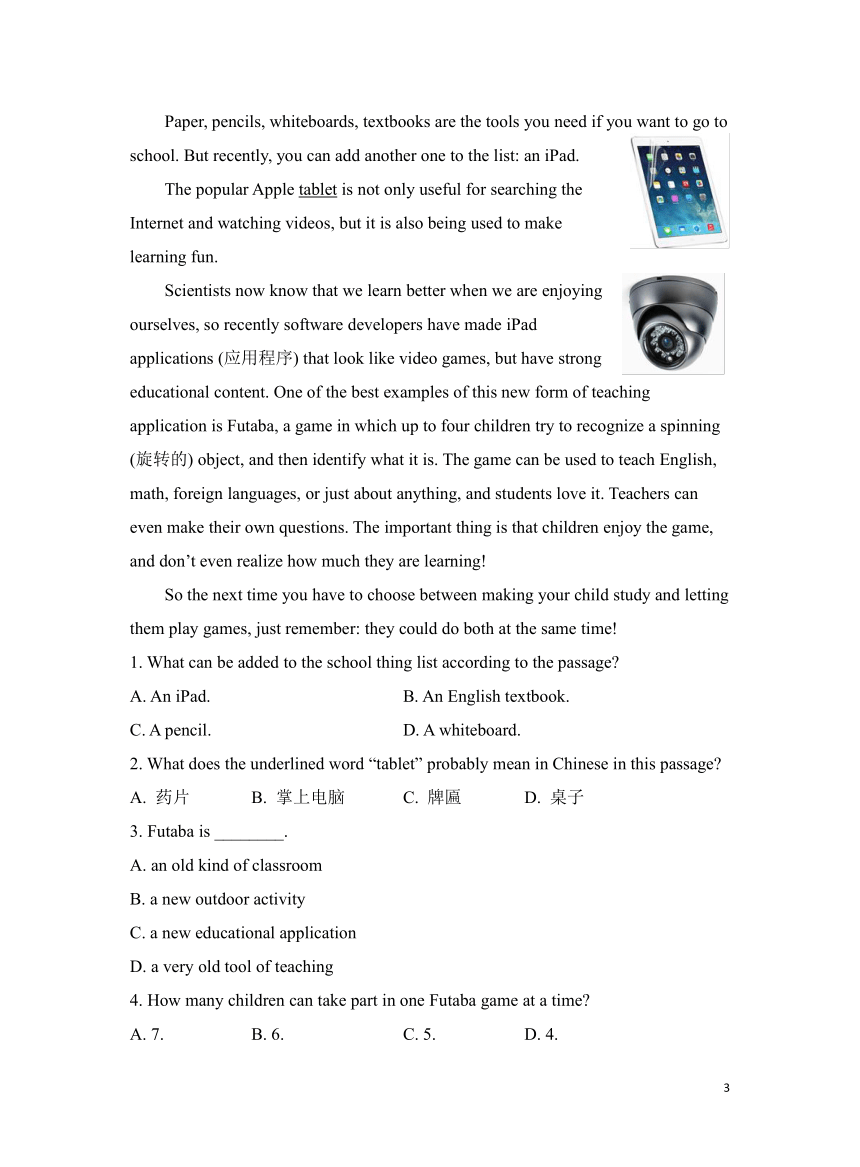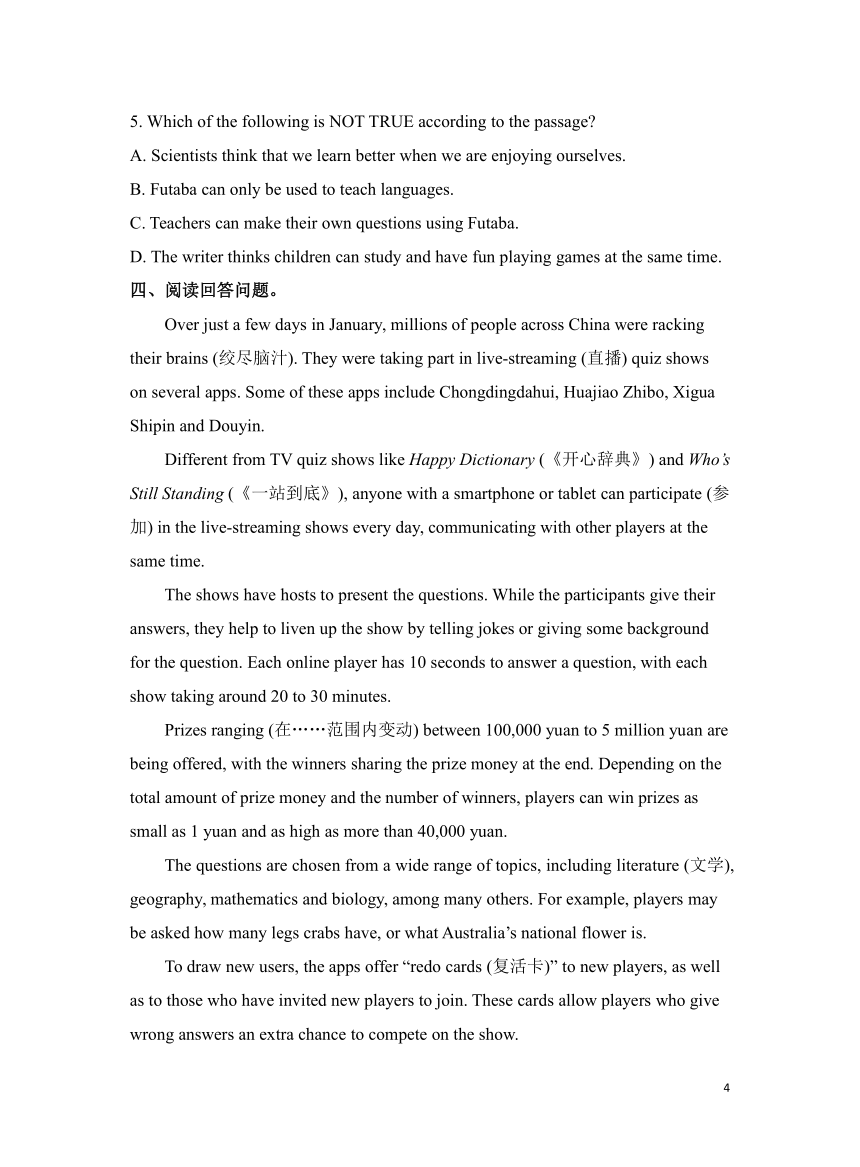初中英语外研版九下Module 2 education Unit 1 They don't sit in rows.作业(含解析)
文档属性
| 名称 | 初中英语外研版九下Module 2 education Unit 1 They don't sit in rows.作业(含解析) |  | |
| 格式 | docx | ||
| 文件大小 | 89.2KB | ||
| 资源类型 | 教案 | ||
| 版本资源 | 外研版 | ||
| 科目 | 英语 | ||
| 更新时间 | 2023-08-30 16:06:47 | ||
图片预览




文档简介
Module 2 Education
Unit 1 They don’t sit in rows.
一、单项选择。
1. —What does your brother look like —________.
A. He is outgoing B. He is really tall and thin
C. He is a student D. He is in hospital
2. Tom’s iPad is much newer than _____. And it is also more expensive.
A. I B. me C. my D. mine
3. —What’s Han Mei like —________.
A. She is a volunteer B. She studies very hard
C. She likes skating D. She is heavy but beautiful
4. How cool Jack is! He ____ a white jacket today.
A. in B. puts on C. wears D. dresses
5. —I hope to see Niagara Falls ____. What about going there
—Niagara Falls would be beautiful, but there is not much to do there.
A. sometimes B. in the day C. a day D. some day
6. —Which do you prefer, coffee or cola
—________, thanks. I’d like a cup of tea.
A. Either B. Both C. Neither D. None
7. —Mum, Bill is coming to dinner this evening.
—OK. Let’s give him _______ to eat.
A. something different B. different anything
C. anything different D. different something
8. Mr. Wang made a ________ at the dinner party.
A. say B. speak C. speech D. talked
9. Usually the students have ________ holiday in summer.
A. a 8-week B. a 8-weeks C. an 8-week D. an 8-weeks
10. I have two sisters, but ________ of them is a teacher.
A. all B. neither C. both D. none
二、完形填空。
In the USA, children start school when they are five years old. In some states they must stay in school 1 they are sixteen. But most students are seventeen or eighteen years old when they 2 secondary schools. There are two kinds of schools in the USA: public schools and private schools. 3 children go to public schools. Their parents do not have to 4 their education because the schools 5 money from the government. If a child goes to a private school, his parents have to get enough money for his schooling. Some parents still 6 private schools though they are much more expensive.
Today about half of the high school students 7 in universities after they finish secondary schools. A student at a state university does not have to pay very much if his parents 8 in that state.
Many students 9 while they are studying at universities. In this way they get into 10 working habits and live by their own hands.
1. A. and B. though C. till D. since
2. A. leave B. come C. study D. pass
3. A. Several B. Most C. A few D. Few
4. A. worry B. pay for C. ask for D. make sure
5. A. lend B. spend C. get D. cost
6. A. go B. hate C. like D. mind
7. A. play B. miss C. change D. study
8. A. was born B. travels C. visit D. live
9. A. work B. study hard C. do sports D. read books
10. A. good B. bad C. well D. better
三、阅读理解。
Using iPads to Make Learning Fun
Paper, pencils, whiteboards, textbooks are the tools you need if you want to go to school. But recently, you can add another one to the list: an iPad.
The popular Apple tablet is not only useful for searching the Internet and watching videos, but it is also being used to make learning fun.
Scientists now know that we learn better when we are enjoying ourselves, so recently software developers have made iPad applications (应用程序) that look like video games, but have strong educational content. One of the best examples of this new form of teaching application is Futaba, a game in which up to four children try to recognize a spinning (旋转的) object, and then identify what it is. The game can be used to teach English, math, foreign languages, or just about anything, and students love it. Teachers can even make their own questions. The important thing is that children enjoy the game, and don’t even realize how much they are learning!
So the next time you have to choose between making your child study and letting them play games, just remember: they could do both at the same time!
1. What can be added to the school thing list according to the passage
A. An iPad. B. An English textbook.
C. A pencil. D. A whiteboard.
2. What does the underlined word “tablet” probably mean in Chinese in this passage
A. 药片 B. 掌上电脑 C. 牌匾 D. 桌子
3. Futaba is ________.
A. an old kind of classroom
B. a new outdoor activity
C. a new educational application
D. a very old tool of teaching
4. How many children can take part in one Futaba game at a time
A. 7. B. 6. C. 5. D. 4.
5. Which of the following is NOT TRUE according to the passage
A. Scientists think that we learn better when we are enjoying ourselves.
B. Futaba can only be used to teach languages.
C. Teachers can make their own questions using Futaba.
D. The writer thinks children can study and have fun playing games at the same time.
四、阅读回答问题。
Over just a few days in January, millions of people across China were racking their brains (绞尽脑汁). They were taking part in live-streaming (直播) quiz shows on several apps. Some of these apps include Chongdingdahui, Huajiao Zhibo, Xigua Shipin and Douyin.
Different from TV quiz shows like Happy Dictionary (《开心辞典》) and Who’s Still Standing (《一站到底》), anyone with a smartphone or tablet can participate (参加) in the live-streaming shows every day, communicating with other players at the same time.
The shows have hosts to present the questions. While the participants give their answers, they help to liven up the show by telling jokes or giving some background for the question. Each online player has 10 seconds to answer a question, with each show taking around 20 to 30 minutes.
Prizes ranging (在……范围内变动) between 100,000 yuan to 5 million yuan are being offered, with the winners sharing the prize money at the end. Depending on the total amount of prize money and the number of winners, players can win prizes as small as 1 yuan and as high as more than 40,000 yuan.
The questions are chosen from a wide range of topics, including literature (文学), geography, mathematics and biology, among many others. For example, players may be asked how many legs crabs have, or what Australia’s national flower is.
To draw new users, the apps offer “redo cards (复活卡)” to new players, as well as to those who have invited new players to join. These cards allow players who give wrong answers an extra chance to compete on the show.
回答下面5个问题。
1. How can we take part in the live-streaming quiz shows
2. How many live-streaming (直播) quiz shows are mentioned in this article
3. How much time does a player have to answer each question
4. Where are the questions chosen from
5. Why do the apps offer “redo cards” to new players
参考答案与解析
一、单项选择。
1. B
【解析】句意:——你的兄弟长什么样?——________。根据问句中look like可知询问人物外貌,故选B。
2. D
【解析】语法分析法。I,主格形式;me,宾格形式;my,形容词性物主代词;mine,名词性物主代词。此处将Tom的iPad和“我”的iPad进行对比,故用名词性物主代词mine,相当于my iPad,故选“mine”。
3. D
【解析】句意:——韩梅是个什么样的人?——_____。A项:她是一个志愿者;B项:她学习非常努力;C项:她喜欢滑冰;D项:她体格很重,但是很漂亮。故选D。
4. C
【解析】本空所填内容在句中作谓语,而介词不能在句中独立作谓语,故排除A;dress表示“给(某人)穿衣服”,宾语一般是人,故排除D;put on表示“穿”的动作;wear表示“穿”的状态。由时间状语today可判断,此处表示“穿”的状态,故选C。
5. D
【解析】sometimes有时候;in the day在白天;a day一天;some day “将来某一天,有朝一日”。根据句意可知选D。
6. C
【解析】由语境可知既不是coffee,也不是cola,Neither表示两者都不。故选C。
7. A
【解析】肯定句中用something;形容词修饰不定代词something作定语要后置。
8. C
【解析】make a speech“作演讲”。
9. C
【解析】此处考查“数词+连字符+单数名词”作前置定语;eight读音的第一个音素为元音,故用冠词an。
10. B
【解析】考查代词辨析。all指三者或三者以上都;neither指两者都不;both指两者都;none指三者或三者以上都不。根据句意:我有两个妹妹,可知是两者之间,故排除A、D两项,根据后半句but表示转折可知用neither。
二、完形填空。
【解析】本文介绍了美国的基本教育制度。文章为我们描述了美国学校孩子上学的年龄,入读的学校,学校的类型:公立学校和私立学校,以及上大学的基本情况等。
1. C till表示“直到”。
2. A 根据句意可知此处应表示“毕业”,用leave school。
3. B 由句意可知此处表示“大多数”,用Most。
4. B 提示:由句意可知此处表示父母不必“支付”教育费用,pay for意为“付钱”。
5. C由句意可知此处表示“学校从政府得到钱”。
6. C 句意为“虽然私立学校更贵,但一些父母们仍喜欢私立学校”。
7. D 由句意可知此处指“在大学学习”。
8. D 由句意可知此处表示“他的父母住在那个州”。
9. A 句意为“很多学生在大学学习时也工作”。
10. A 由句意可知此处表示他们养成“好的”工作习惯。
三、阅读理解。
【解析】文章主要介绍的是一款新兴的学习工具,iPad。iPad是苹果集团推出的一款掌上电脑,可以帮助孩子们学习,此外还介绍了一个配套软件,Futaba,每次允许四个孩子同时玩游戏,在玩游戏的过程中还可以学习英语,数学和外语等知识。
1. A 推理判断题,文中提到“But recently, you can add another one to the list: an iPad”现在,你可以在你的列表上加上一个东西,那就是iPad,由此可知选择A。
2. B 词义猜测题,文中提到“an iPad”,我们知道,这是一款苹果系列的掌上电脑,由此确定选择B。
3. C 推理判断题,文中提到“The game can be used to teach English, math, foreign languages, or just about anything, and students love it” Futaba是一款游戏,这款游戏可以教孩子英语、数学、外语和其他任何东西,由此确定选择C。
4. D 推理判断题,文中提到“Futaba, a game in which up to four children try to recognize a spinning object Futaba是一款游戏,是四个小孩子一起辨认一个旋转物体,由此确定是4个孩子,选择D。
5. B 推理判断题,文中提到“The game can be used to teach English, math, foreign languages, or just about anything, and students love it” Futaba是一款游戏,这款游戏可以教孩子英语、数学、外语和其他任何东西,由此确定选择B。
四、阅读回答问题。
【解析】这是一篇日常生活类阅读,主要介绍一种可以在线回答问题赢得奖金的应用程序非常受欢迎,每个玩家通过手机或平板电脑回答问题,年底分享奖金。问题来自很多方面,这个应用程序还为玩家提供“复活卡”,以便吸引更多的人加入。
1. By using a smartphone or tablet. 细节理解题。根据第二段可知,人们通过使用智能手机或者平板电脑就可以参加智力直播。
2. Four. 细节理解题。根据第一段最后一句“Some of these apps include Chongdingdahui, Huajiao Zhibo, Xigua Shipin and Douyin.”可知,提到了四种直播竞赛节目。
3. 10 seconds. 细节理解题。根据第三段“Each online player has 10 seconds to answer a question, with each show taking around 20 to 30 minutes.”可知,每人必须在10秒钟时间回答。
4. From a wide range of topics. 细节理解题。根据第五段首句“The questions are chosen from a wide range of topics, …”可知,这些问题选自广泛话题。
5. To draw new users. 推理判断题。根据最后一段第一句“To draw new users, the apps offer “redo cards (复活卡)” to new players,”可知,为了吸引新的使用者,应用程序给新的玩手提供复活卡。
1
Unit 1 They don’t sit in rows.
一、单项选择。
1. —What does your brother look like —________.
A. He is outgoing B. He is really tall and thin
C. He is a student D. He is in hospital
2. Tom’s iPad is much newer than _____. And it is also more expensive.
A. I B. me C. my D. mine
3. —What’s Han Mei like —________.
A. She is a volunteer B. She studies very hard
C. She likes skating D. She is heavy but beautiful
4. How cool Jack is! He ____ a white jacket today.
A. in B. puts on C. wears D. dresses
5. —I hope to see Niagara Falls ____. What about going there
—Niagara Falls would be beautiful, but there is not much to do there.
A. sometimes B. in the day C. a day D. some day
6. —Which do you prefer, coffee or cola
—________, thanks. I’d like a cup of tea.
A. Either B. Both C. Neither D. None
7. —Mum, Bill is coming to dinner this evening.
—OK. Let’s give him _______ to eat.
A. something different B. different anything
C. anything different D. different something
8. Mr. Wang made a ________ at the dinner party.
A. say B. speak C. speech D. talked
9. Usually the students have ________ holiday in summer.
A. a 8-week B. a 8-weeks C. an 8-week D. an 8-weeks
10. I have two sisters, but ________ of them is a teacher.
A. all B. neither C. both D. none
二、完形填空。
In the USA, children start school when they are five years old. In some states they must stay in school 1 they are sixteen. But most students are seventeen or eighteen years old when they 2 secondary schools. There are two kinds of schools in the USA: public schools and private schools. 3 children go to public schools. Their parents do not have to 4 their education because the schools 5 money from the government. If a child goes to a private school, his parents have to get enough money for his schooling. Some parents still 6 private schools though they are much more expensive.
Today about half of the high school students 7 in universities after they finish secondary schools. A student at a state university does not have to pay very much if his parents 8 in that state.
Many students 9 while they are studying at universities. In this way they get into 10 working habits and live by their own hands.
1. A. and B. though C. till D. since
2. A. leave B. come C. study D. pass
3. A. Several B. Most C. A few D. Few
4. A. worry B. pay for C. ask for D. make sure
5. A. lend B. spend C. get D. cost
6. A. go B. hate C. like D. mind
7. A. play B. miss C. change D. study
8. A. was born B. travels C. visit D. live
9. A. work B. study hard C. do sports D. read books
10. A. good B. bad C. well D. better
三、阅读理解。
Using iPads to Make Learning Fun
Paper, pencils, whiteboards, textbooks are the tools you need if you want to go to school. But recently, you can add another one to the list: an iPad.
The popular Apple tablet is not only useful for searching the Internet and watching videos, but it is also being used to make learning fun.
Scientists now know that we learn better when we are enjoying ourselves, so recently software developers have made iPad applications (应用程序) that look like video games, but have strong educational content. One of the best examples of this new form of teaching application is Futaba, a game in which up to four children try to recognize a spinning (旋转的) object, and then identify what it is. The game can be used to teach English, math, foreign languages, or just about anything, and students love it. Teachers can even make their own questions. The important thing is that children enjoy the game, and don’t even realize how much they are learning!
So the next time you have to choose between making your child study and letting them play games, just remember: they could do both at the same time!
1. What can be added to the school thing list according to the passage
A. An iPad. B. An English textbook.
C. A pencil. D. A whiteboard.
2. What does the underlined word “tablet” probably mean in Chinese in this passage
A. 药片 B. 掌上电脑 C. 牌匾 D. 桌子
3. Futaba is ________.
A. an old kind of classroom
B. a new outdoor activity
C. a new educational application
D. a very old tool of teaching
4. How many children can take part in one Futaba game at a time
A. 7. B. 6. C. 5. D. 4.
5. Which of the following is NOT TRUE according to the passage
A. Scientists think that we learn better when we are enjoying ourselves.
B. Futaba can only be used to teach languages.
C. Teachers can make their own questions using Futaba.
D. The writer thinks children can study and have fun playing games at the same time.
四、阅读回答问题。
Over just a few days in January, millions of people across China were racking their brains (绞尽脑汁). They were taking part in live-streaming (直播) quiz shows on several apps. Some of these apps include Chongdingdahui, Huajiao Zhibo, Xigua Shipin and Douyin.
Different from TV quiz shows like Happy Dictionary (《开心辞典》) and Who’s Still Standing (《一站到底》), anyone with a smartphone or tablet can participate (参加) in the live-streaming shows every day, communicating with other players at the same time.
The shows have hosts to present the questions. While the participants give their answers, they help to liven up the show by telling jokes or giving some background for the question. Each online player has 10 seconds to answer a question, with each show taking around 20 to 30 minutes.
Prizes ranging (在……范围内变动) between 100,000 yuan to 5 million yuan are being offered, with the winners sharing the prize money at the end. Depending on the total amount of prize money and the number of winners, players can win prizes as small as 1 yuan and as high as more than 40,000 yuan.
The questions are chosen from a wide range of topics, including literature (文学), geography, mathematics and biology, among many others. For example, players may be asked how many legs crabs have, or what Australia’s national flower is.
To draw new users, the apps offer “redo cards (复活卡)” to new players, as well as to those who have invited new players to join. These cards allow players who give wrong answers an extra chance to compete on the show.
回答下面5个问题。
1. How can we take part in the live-streaming quiz shows
2. How many live-streaming (直播) quiz shows are mentioned in this article
3. How much time does a player have to answer each question
4. Where are the questions chosen from
5. Why do the apps offer “redo cards” to new players
参考答案与解析
一、单项选择。
1. B
【解析】句意:——你的兄弟长什么样?——________。根据问句中look like可知询问人物外貌,故选B。
2. D
【解析】语法分析法。I,主格形式;me,宾格形式;my,形容词性物主代词;mine,名词性物主代词。此处将Tom的iPad和“我”的iPad进行对比,故用名词性物主代词mine,相当于my iPad,故选“mine”。
3. D
【解析】句意:——韩梅是个什么样的人?——_____。A项:她是一个志愿者;B项:她学习非常努力;C项:她喜欢滑冰;D项:她体格很重,但是很漂亮。故选D。
4. C
【解析】本空所填内容在句中作谓语,而介词不能在句中独立作谓语,故排除A;dress表示“给(某人)穿衣服”,宾语一般是人,故排除D;put on表示“穿”的动作;wear表示“穿”的状态。由时间状语today可判断,此处表示“穿”的状态,故选C。
5. D
【解析】sometimes有时候;in the day在白天;a day一天;some day “将来某一天,有朝一日”。根据句意可知选D。
6. C
【解析】由语境可知既不是coffee,也不是cola,Neither表示两者都不。故选C。
7. A
【解析】肯定句中用something;形容词修饰不定代词something作定语要后置。
8. C
【解析】make a speech“作演讲”。
9. C
【解析】此处考查“数词+连字符+单数名词”作前置定语;eight读音的第一个音素为元音,故用冠词an。
10. B
【解析】考查代词辨析。all指三者或三者以上都;neither指两者都不;both指两者都;none指三者或三者以上都不。根据句意:我有两个妹妹,可知是两者之间,故排除A、D两项,根据后半句but表示转折可知用neither。
二、完形填空。
【解析】本文介绍了美国的基本教育制度。文章为我们描述了美国学校孩子上学的年龄,入读的学校,学校的类型:公立学校和私立学校,以及上大学的基本情况等。
1. C till表示“直到”。
2. A 根据句意可知此处应表示“毕业”,用leave school。
3. B 由句意可知此处表示“大多数”,用Most。
4. B 提示:由句意可知此处表示父母不必“支付”教育费用,pay for意为“付钱”。
5. C由句意可知此处表示“学校从政府得到钱”。
6. C 句意为“虽然私立学校更贵,但一些父母们仍喜欢私立学校”。
7. D 由句意可知此处指“在大学学习”。
8. D 由句意可知此处表示“他的父母住在那个州”。
9. A 句意为“很多学生在大学学习时也工作”。
10. A 由句意可知此处表示他们养成“好的”工作习惯。
三、阅读理解。
【解析】文章主要介绍的是一款新兴的学习工具,iPad。iPad是苹果集团推出的一款掌上电脑,可以帮助孩子们学习,此外还介绍了一个配套软件,Futaba,每次允许四个孩子同时玩游戏,在玩游戏的过程中还可以学习英语,数学和外语等知识。
1. A 推理判断题,文中提到“But recently, you can add another one to the list: an iPad”现在,你可以在你的列表上加上一个东西,那就是iPad,由此可知选择A。
2. B 词义猜测题,文中提到“an iPad”,我们知道,这是一款苹果系列的掌上电脑,由此确定选择B。
3. C 推理判断题,文中提到“The game can be used to teach English, math, foreign languages, or just about anything, and students love it” Futaba是一款游戏,这款游戏可以教孩子英语、数学、外语和其他任何东西,由此确定选择C。
4. D 推理判断题,文中提到“Futaba, a game in which up to four children try to recognize a spinning object Futaba是一款游戏,是四个小孩子一起辨认一个旋转物体,由此确定是4个孩子,选择D。
5. B 推理判断题,文中提到“The game can be used to teach English, math, foreign languages, or just about anything, and students love it” Futaba是一款游戏,这款游戏可以教孩子英语、数学、外语和其他任何东西,由此确定选择B。
四、阅读回答问题。
【解析】这是一篇日常生活类阅读,主要介绍一种可以在线回答问题赢得奖金的应用程序非常受欢迎,每个玩家通过手机或平板电脑回答问题,年底分享奖金。问题来自很多方面,这个应用程序还为玩家提供“复活卡”,以便吸引更多的人加入。
1. By using a smartphone or tablet. 细节理解题。根据第二段可知,人们通过使用智能手机或者平板电脑就可以参加智力直播。
2. Four. 细节理解题。根据第一段最后一句“Some of these apps include Chongdingdahui, Huajiao Zhibo, Xigua Shipin and Douyin.”可知,提到了四种直播竞赛节目。
3. 10 seconds. 细节理解题。根据第三段“Each online player has 10 seconds to answer a question, with each show taking around 20 to 30 minutes.”可知,每人必须在10秒钟时间回答。
4. From a wide range of topics. 细节理解题。根据第五段首句“The questions are chosen from a wide range of topics, …”可知,这些问题选自广泛话题。
5. To draw new users. 推理判断题。根据最后一段第一句“To draw new users, the apps offer “redo cards (复活卡)” to new players,”可知,为了吸引新的使用者,应用程序给新的玩手提供复活卡。
1
同课章节目录
- Module 1 Travel
- Unit 1 We toured the city by bus and by taxi
- Unit 2 It's a long story.
- Unit 3 Language in use
- Module 2 Education
- Unit 1 They don't sit in rows.
- Unit 2 What do I like best about school?
- Unit 3 Language in use
- Module 3 Life now and then
- Unit 1 They sometimes work harder.
- Unit 2 I think life is better today.
- Unit 3 Language in use.
- Module 4 Rules and suggestions
- Unit 1 You must be careful of falling stones.
- Unit 2 we must keep the camp clean.
- Unit 3 Language in use.
- Revison A
- Module 5 Look after yourself
- Unit 1 We'd better get you to hospital.
- Unit 2 Get off the sofa!
- Unit 3 Language in use.
- Module 6 Eating togethe
- Unit 1 When is the school-leavers' party?
- Unit 2 Knives and forks are used for most Western
- Unit 3 Language in use
- Module 7 English for you and me
- Unit 1 Have you ever been to an English corner?
- Unit 2 We all own English.
- Unit 3 Language in use
- Module 8 My future life
- Unit 1 Here's to our friendship and the future
- Unit 2 I know that you will be better at maths.
- Unit 3 Language in use
- Revison B
